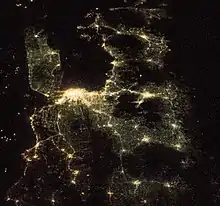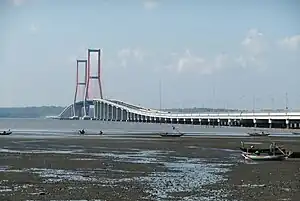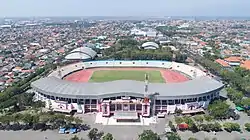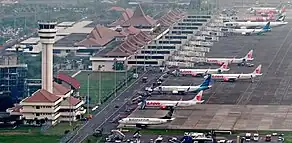Surabaya metropolitan area
Gerbangkertosusila | |
|---|---|
| Other transcription(s) | |
| • Javanese | ꦒꦼꦂꦧꦁꦏꦼꦂꦠꦱꦸꦱꦶꦭ Gerbangkertasusila |
From top, left to right: Downtown Surabaya, aerial view of Gresik Regency, Mojokerto at night, Suramadu Bridge that connects Surabaya and Bangkalan Regency, Brahu Temple Trowulan in Mojokerto Regency, Gelora Delta Stadium in Sidoarjo Regency, a mangrove tree in Lamongan Regency. | |
 | |
| Country | |
| Province | |
| Core city | Surabaya |
| Satellite city | Mojokerto |
| Regencies | Gresik Regency Bangkalan Regency Mojokerto Regency Sidoarjo Regency Lamongan Regency |
| Area | |
| • Metro | 6,310.06 km2 (2,436.33 sq mi) |
| Population (mid 2022 estimate) | |
| • Urban | 2,987,863 |
| • Metro | 9,975,878 |
| • Metro density | 1,600/km2 (4,100/sq mi) |
| Time zone | UTC+7 (Indonesia Western Time) |
| GDP (nominal) | 2022[1][2] |
| - Total | |
| - Per capita | |
| Highest elevation 3,339 m/10,955 ft (Arjuno-Welirang, in Mojokerto Regency) | |
The Surabaya metropolitan area, or known locally as Gerbangkertosusila (Javanese: ꦒꦼꦂꦧꦁꦏꦼꦂꦠꦱꦸꦱꦶꦭ, romanized: Gěrbangkěrtåsusila, from Gresik-Bangkalan-Mojokerto-Surabaya-Sidoarjo-Lamongan), is a metropolitan area in East Java, Indonesia. It is the country's second-largest metropolitan area, after Jakarta metropolitan area. Gerbangkertosusila had also been used in presidential decree to refer to larger region which include Jombang, Bojonegoro, and Tuban.[3]
Definition

Grebangkertosusila is an official acronym of "Gresik Bangkalan Mojokerto Surabaya Sidoarjo Lamongan", a main metropolitan or planning area in East Java consisting of the seven cities and regencies with those names (Mojokerto is both a city and a separate regency).[4][5] It has an area of 6,310.06 km2, and at the 2020 Census had a population of 9,924,509,[6] rising to 9,975,878 according to the official estimates as at mid 2022.[7]
The national government regards the Surabaya Metropolitan Area as including only Surabaya, Sidoarjo Regency, and Gresik Regency, known as "Zona Surabaya Raya".[8] Gresik Regency includes Bawean Island, covering some 196 km2 and lying north of Java; however Bawean Island is excluded from the Metropolitan Area.
Surabaya traditionally constituted Indonesia's second-largest metropolitan area, after Jakarta, but fast growing Bandung Metropolitan Area (in West Java) is since 2005 more populous. However, the extended metropolitan area of Surabaya is second in Indonesia only to Jabodetabek. The areas and populations at the 2010 Census,[9] the 2020 Census[10] and according to the official estimates for mid 2022,[11] are shown below for the component parts of the metropolitan area.
| Administrative Region |
Area (km²) mid 2022 |
Pop'n 2010 Census |
Pop'n 2020 Census |
Pop'n mid 2022 estimate |
Density (per km2) mid 2022 |
|---|---|---|---|---|---|
| Surabaya Municipality | 350.54 | 2,765,487 | 2,874,314 | 2,987,863 | 8,933.66 |
| Gresik Regency (a) | 1,193.76 | 1,177,042 | 1,311,215 | 1,291,518 | 1,081.89 |
| Sidoarjo Regency | 719.34 | 1,941,497 | 2,082,800 | 1,955,002 | 2,717.77 |
| Zona Surabaya Raya | 2,247.55 | 5,884,026 | 6,268,329 | 6,234,383 | 2,773.86 |
| Bangkalan Regency (on Madura island) | 1,260.14 | 906,761 | 1,060,377 | 1,086,620 | 862.30 |
| Mojokerto Regency | 969.36 | 1,025,443 | 1,119,209 | 1,133,584 | 1,169.41 |
| Mojokerto Municipality | 20.21 | 120,196 | 132,424 | 134,350 | 6,647.70 |
| Lamongan Regency | 1,812.80 | 1,179,059 | 1,344,170 | 1,386,941 | 765.08 |
| Greater Surabaya metropolitan area | 6,310.06 | 9,115,485 | 9,924,509 | 9,975,878 | 1,580.95 |
Note: (a) The island of Bawean, while part of Gresik Regency, is not technically part of the Metropolitan area; nevertheless for convenience the figures given here include Bawean.
Reference: Statistics Indonesia[12]
Transportation
Surabaya metropolitan area has air connection via Juanda International Airport.
Surabaya metropolitan area has five commuter rail services with the network similar with KRL Commuterline in Jakarta metropolitan area. The services connects Surabaya city center to the neighboring cities and regency in the area.
The Suroboyo Bus city bus is serving Surabaya, using plastic waste as a form of payment. Ever since May 2022, however, direct payment using plastic bottles on the bus has been terminated and plastic waste has to be exchanged in designated points beforehand.[13]
See also
References
- ↑ Badan Pusat Statistik Jawa Timur (2022). Produk Domestik Regional Bruto Kabupaten/kota di Jawa Timur 2019-2021. Surabaya: Badan Pusat Statistik.
- ↑ "PDRB Atas Dasar Harga Berlaku Menurut Pengeluaran Kabupaten/Kota (Juta Rupiah) [SERI 2010], 2021-2022". www.bps.go.id.
- ↑ BeritaSatu.com. "Presiden Teken Prepres Percepatan Pembangunan Gerbangkertosusila". beritasatu.com (in Indonesian). Retrieved 2023-09-12.
- ↑ "Garuda » Referensi Ilmiah Indonesia". Archived from the original on 2012-07-27. Retrieved 2011-04-29.
- ↑ "Konsep Metropolitan Banjar Bakula Akhirnya Diakui Pusat - Situs Resmi Pemerintah Provinsi Kalsel". Archived from the original on 2012-10-25. Retrieved 2012-03-19.
- ↑ Badan Pusat Statistik, Jakarta, 2021.
- ↑ Badan Pusat Statistik, Jakarta, 2023.
- ↑ ":: Dinas Pertanian Jatim ::". Archived from the original on 2012-03-23. Retrieved 2011-04-29.
- ↑ Biro Pusat Statistik, Jakarta, 2011.
- ↑ Badan Pusat Statistik, Jakarta, 2021.
- ↑ Badan Pusat Statistik, Jakarta, 2023.
- ↑ Statistics Indonesia Jawa Timur Hasil Sensus 2010, 12 Agustus 2011
- ↑ "Tukar Botol Plastik di Dalam Suroboyo Bus Ditiadakan" (in Indonesian). Radar Surabaya.
- Mera, Koichi and Renaud, Bertrand (2001). Asia's Financial Crisis and the Role of Real Estate. M.E. Sharpe. ISBN 0-7656-0642-9







